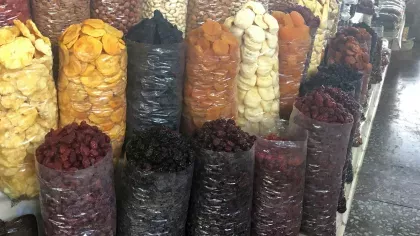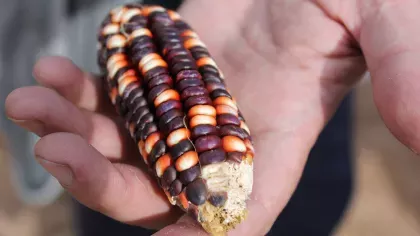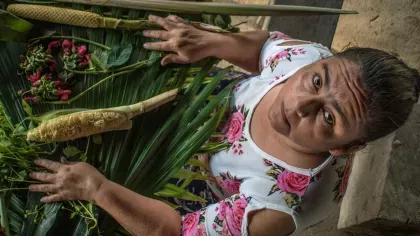5 July 2022
Hope for a forgotten grain in Cornwall
Re-rooting biocultural diversity in a complex world

“Pillas”, wrote the Cornish linguist and historian Robert Morton Nance in 1930, “sometimes called “pill-corn” or “naked oats", […] “smaller than oats and without husk, was formerly a common crop in Cornwall, but seems now to have become quite extinct.”
Adventurers and historians in earlier centuries described this intriguing grain as cultivated in abundance towards Land’s End where it thrived on marginal soils and was often the ‘farewell crop’ - the last to be sown in a rotation.
It made a hearty porridge known as ‘gerty-milk’ - stirred over a slow fire and ground into oatmeal - and was used to fatten pigs and calves, while thatching rope and bonnets were woven from its fine straw.
But by the mid-nineteenth century it was gone from Cornish fields.


Reviving the small naked oat
I first learned about pillas when visiting my grandad a few years ago on his 93rd birthday when, to my disbelief, his wife showed me a patch of it growing in their garden and gave me some seedlings.
Like Morton Nance, my grandad was also a Cornish linguist and driven to revive elements of local culture that he felt to be endangered.
The ‘small naked oat’, as it is otherwise known (referring to its small hulless grain), was one such element and it has since become the cornerstone of my doctoral study.
As an ethnobotanical researcher, I explore people-plant relationships and I am particularly interested in their shaping and re-shaping over time.
My project draws on my own efforts to revive pillas, as well as incorporating historical ethnobotanical insights, as part of a wider investigation into the revitalisation of local grain systems in collaboration with farmers, bakers, scientists and others.

Replenishing eroded foodscapes
Globally, our diets are becoming increasingly homogenised; dominated by staples such as wheat, rice, maize, and potatoes.
However, it is not just this narrowed range of foods that is of concern, but the depletion of diversity within them. In striving for yield and uniformity, modern crop breeding has displaced much of the genetic diversity encoded in traditional landraces (locally-adapted, culturally significant and diverse crop varieties).
'Improved’ varieties tend to demand chemical inputs, while reduced diversity in farmers’ fields equals less in-built resilience to climate-change, pests, diseases and socio-economic shocks.
Re-rooting traditional crops in our landscapes is one way of counteracting the devastating erosion of biocultural diversity witnessed by our food and farming systems; offering the potential to re-diversify fields, improve nutrition, reduce inputs, empower small-scale farmers and re-enliven local cultures.
In recent decades numerous neglected grains such as fonio in West Africa, bere barley in Scotland and various wheat landraces in Turkey, have experienced a renaissance.

It’s complicated
The pathway to recovery, however, is not always straightforward. Pillas may seem to fit the romantic lost-and-found narrative, but in truth its story is more complex.
While pillas did not go extinct, as Morton Nance thought, its traditional cultivation did cease, extinguishing its former embeddedness in the landscape, as well as the living ethnobotanical knowledge associated with it; aspects of which may never be recovered.
As such it is a potent reminder of the need to conserve crop diversity both in seedbanks and in farmers’ fields.
Complicating matters further, the seedlings I inherited on grandad’s birthday were in fact not pillas, but another kind of naked oat which it closely resembles; the material wrongly identified and sent on by a seedbank in the 1980s.
This so-called ‘large naked oat’ evolved separately but in parallel to pillas, arriving in Western Europe in the early-nineteenth century from China and Mongolia around the same time that pillas disappeared from Cornish fields - from which stemmed centuries of confusion over the two.

Hope for revitalisation
Remarkably however, pillas did make its way into seedbanks, having been maintained and exchanged as a botanical curiosity during the late nineteenth and early twentieth centuries; although limited material remains which has inevitably undergone genetic erosion.
It is not yet clear how many varieties it represents, or indeed where they are from. Evidence suggests its traditional cultivation was not restricted to Cornwall, but once spread across Wales, England, Ireland, and Brittany.
Still, this offers an exciting opportunity to re-discover its potential and experimental plots are now being cultivated at a community field and on several farms in the Southwest.

Meanwhile, there is increasing interest in the large naked oat, grown organically as a wholegrain and for oat milk, spurred on by UK farmers, bakers and others working to improve the ways in which we cultivate and consume grains.
The pasts and presents of both naked oats persistently intertwine, and I have gained insights through considering their histories and taxonomy, as well as their future potential, in parallel.
Complex, ambiguous and incomplete, yet rooted in hope, the story of pillas reflects both the challenges and opportunities of recovering eroded biocultural diversity in today’s world.




